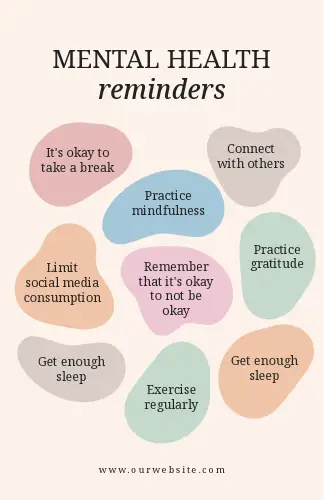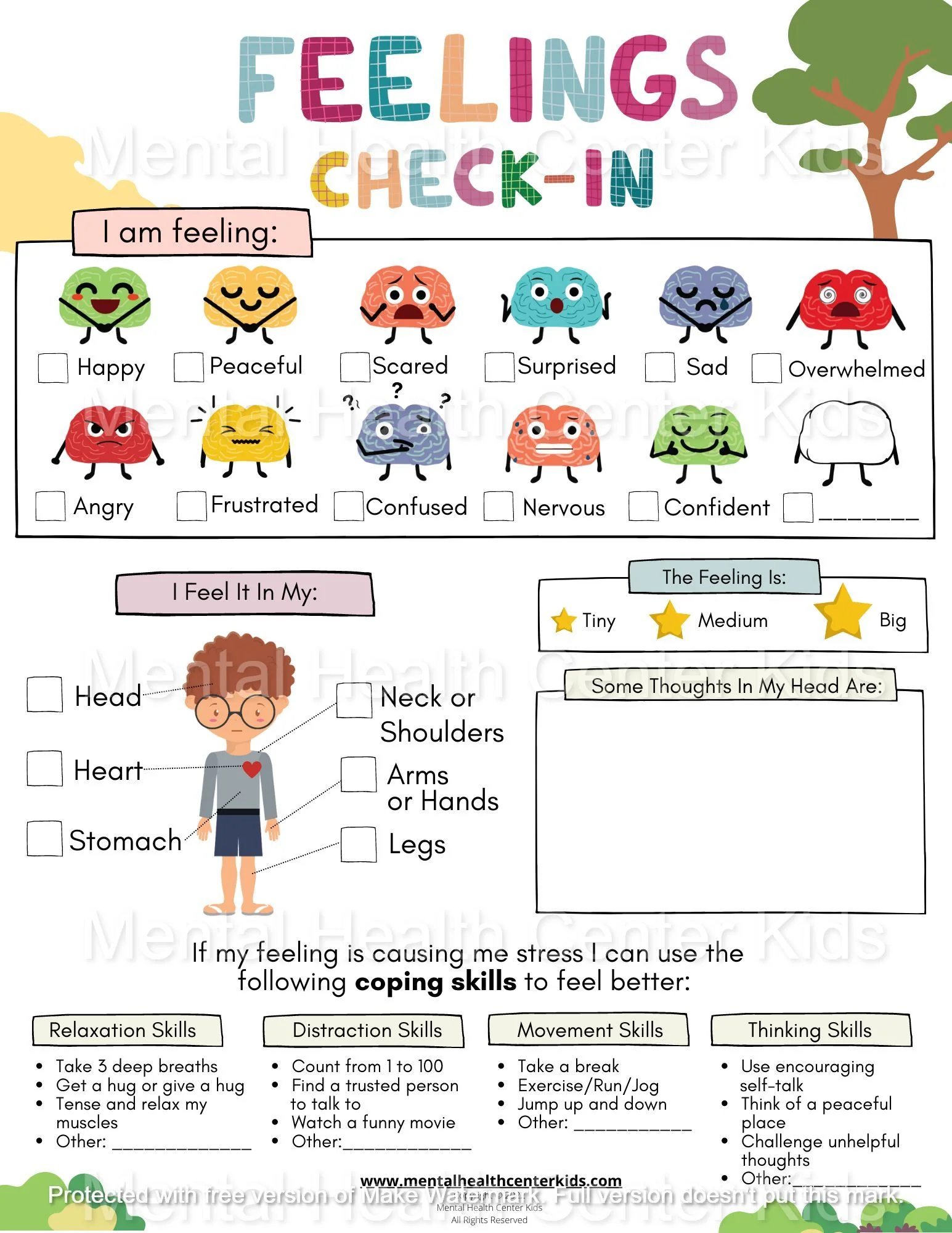| Table of Contents: Mental Health Check-In Worksheet Introduction What Is a Mental Health Check-In Worksheet? Why Mental Health Check-Ins Are Important Benefits of Using a Mental Health Check-In Worksheet For Individuals For Therapists and Counselors For Workplaces and Schools Key Components of an Effective Mental Health Check-In Worksheet Emotional Self-Assessment Mood Tracker Stress and Anxiety Levels Sleep, Diet, and Physical Health Thought Patterns and Mindfulness Action Plan or Coping Strategies How to Use a Mental Health Check-In Worksheet Effectively Daily vs. Weekly Use Guided vs. Self-Guided Check-Ins Journaling with the Worksheet Printable vs. Digital Mental Health Worksheets Pros and Cons of Each Format Best Apps and Tools to Use Mental Health Check-In Worksheets for Specific Audiences Kids and Teens Adults Employees and Remote Workers Students Therapists/Clients Examples and Templates Sample Daily Mental Health Check-In Worksheet (Free Template) Weekly Mental Health Check-In Template PDF Download Options How to Create Your Own Mental Health Check-In Worksheet Step-by-Step Guide Tools and Resources for DIY Templates FAQs about Mental Health Check-In Worksheets How Often Should I Use One? Can It Replace Therapy? What If I Don’t Know How I Feel? Final Thoughts and Resources When to Seek Professional Help Recommended Books, Apps, and Websites Download Your Free Worksheet Now (CTA) |
- Introduction
In the era of modernization, it is crucial to prioritize your mental health and wellness. We check our phones, emails, and bank accounts daily, but do we often check our mental health? The Mental Health Check-In Worksheet is a powerful tool to assess your mental wellness.
It is designed to help individuals and offers a simple and effective way to check their emotions, thoughts, and overall wellness. This tool reduces the anxiety and tensions of individuals. It works like a mirror and reveals things below the surface and guides you completely about self-awareness and mental wellness.

In this article, we will explore the Mental Health Check-in worksheet, its importance, uses, benefits, and templates.
Let’s take the first step together—checking in with your mind and giving it the care it truly deserves.
- Benefits of Using a Mental Health Check-In Worksheet
For Individuals
If you are facing anxiety, then a Mental Health Check-In Worksheet is an important tool for you. This tool understands your thoughts and feelings and connects your emotions with dots. It observes everything happening around us.
It provides help in managing stress, tension, and anxiety. It also creates changes in your mood and behavior, which is the first step towards change. When you check yourself daily, you take care of your mental wellness and get encouragement.
For Therapists and Counselors
These worksheets are very beneficial for mental health professionals. These sheets make sessions more focused. It gives a different perspective to therapists, which makes the sessions more productive. When each point is written on the sheet, improvement, setbacks, or emotional triggers become easier, which encourages the client. It is better to write down your feelings than to say them out loud.
For Workplaces and Schools
This sheet promotes emotional wellness. Individuals feel support in a busy office or high-stress classroom. The sheet discusses the priority of mental health. Through this worksheet, people mentally gain balance and engage, motivate, or do productive things. Worksheets highlight stress, anxiety, and tension of individuals to reduce their stress.
- Key Components of an Effective Mental Health Check-In Worksheet
Emotional Self-Assessment
The Mental Health Check-in worksheet helps in your emotional self-assessment. If you feel calm, anxious, sad, hopeless, or numb, then you can write down your emotions as a result of awareness. You can explore your feelings in this section without judgment.
Identifying your emotions is the first step in learning how to manage them in a healthy way.
Mood Tracker
Tracking your mood daily or weekly can be helpful for you. Because if you are tired due to lack of sleep one day, then you can notice it the next day if you feel better. The rating of the mood tracker should be from 1 to 10 for the next days, which makes your mood better.
Over time, this can help you connect your mood to habits, environments, or events, so you can make better choices.
Sleep, Diet, and Physical Health
There is a deep connection beyond mental or physical health. This worksheet explores what kind of diet you should follow, what you need, or how your body overall feels.
Less sleep, irregular meals, and lack of movement play a serious role in spoiling your mood.
Thought Patterns and Mindfulness
This part of the worksheet refreshes your mind and helps you get out of past memories and stay in the present and think about the future.
Being aware of unhelpful thought patterns can help you challenge and reframe them. Mindfulness practices can help you feel more grounded and in control.
Action Plan or Coping Strategies
This section tells you what to do next. This can be any small action you like, such as walking in, talking to a friend on the phone, setting boundaries, or simply setting a reminder.
Making plans and strategies empowers you to take action. This is the first step towards better mental health.
- How to Use a Mental Health Check-In Worksheet Effectively?
Daily vs. Weekly Use
Daily Check-Ins in Mental Health Check-In Worksheet
Daily Check-Ins is best for emotional regulation, stress management, or mood tracking.
Benefits:
- It helps build awareness of mood shifts and triggers
- It promotes consistent self-reflection
- It supports habit formation and emotional resilience
Keep it short and focused on mood, energy, sleep, and a highlight/lowlight of the day.
Weekly Check-Ins in Mental Health Check-In Worksheet
Weekly check-ins are the best way to track pattern recognition, reflection, or progress.
Benefits:
- It allows for deeper insight into recurring challenges or improvements
- It is less time-intensive
- It encourages big-picture thinking
Weekly check-ins summarize themes or strategies of the whole week or set goals for next week.
Guided vs. Self-Guided Check-Ins
Guided Check-Ins
Include prompts like
“What emotion stood out today?”
“What was a trigger or challenge you faced?”
“How did you take care of yourself?”
Best for: Beginners, therapy clients, or those who struggle to articulate emotions
Guided check-ins are best to express emotions of beginners or therapy clients.
Pros: It is structured, easier to start, and reduces overwhelm, anxiety, or tension.
Cons: It is less flexible and might feel limiting over time.
Self-Guided Check-Ins
You decide what to reflect on
It is best for experienced journalers or those seeking creative freedom.
Pros: It is personalized, intuitive, and adaptable.
Cons: It can lack consistency or depth if not intentional
Journaling with the Mental Health Check-In Worksheet
Pairing a mental health worksheet with journaling:
- It adds depth to your emotions.
- It provides context to patterns.
- It encourages expressive writing
Tip: It ends your journal with a self-compassionate statement or action step for the future.
- Printable vs. 💻 Digital Mental Health Check-In Worksheet
| Feature | Printable | Digital |
| Accessibility | Easy to print, no tech needed | Access anywhere, even on the go |
| Privacy | More private (if kept safe) | May require passcodes or secure storage |
| Customizability | Easy to write/doodle on freely | Can include checkboxes, drop-downs |
| Integration | Physical tracking (binders, journals) | Can sync with mental health apps |
| Eco-friendly | Uses paper and ink | More sustainable, no printing required |
6. Best Apps and Tools to Use
🔹 For Digital Check-Ins:
- Daylio—It tracks mood and habit with customizable icons
- Reflectly—It gives AI-powered journaling prompts
- Moodnotes—It combines CBT with mood tracking
- Notion or Google Docs—It builds custom templates
- MindDoc—It offers clinical-style mental health tracking
🔹 For Printable Worksheets:
- Therapist Aid—It has the facility of Free downloadable PDFs
- PositivePsychology.com—It provides evidence-based templates
- Pinterest—It’s a source for creative, user-made worksheet designs
7. Mental Health Check-In Worksheets for Specific Audiences
🧒 Kids and Teens
Features to include:
- Emoji-based mood scales
- Colorful visuals
- Prompts like: “What made you smile today?”
- Reward or sticker systems
Tip: Pair with short breathing exercises or coloring pages.
🧑 Adults
Focus areas:
- Stress levels
- Sleep patterns
- Self-care habits
- Work/life balance
Tip: Include sections for gratitude, goal-setting, and CBT-style reframing.
🧑💼 Employees and Remote Workers
Key sections:
- Burnout indicators
- Productivity vs. stress ratings
- Social connection tracking

8. Sample Daily Mental Health Check-In Worksheet
(Free Template – Printable or Digital)
Title: Daily Mental Health Check-In
| Question | Your Response |
| How am I feeling emotionally right now? | (Use a mood word or emoji) |
| How am I feeling physically? | (Tired, energetic, tense, etc.) |
| What thoughts are on my mind? | |
| What happened today that impacted my mood? | |
| Did I practice self-care? | (Yes/No – What did you do?) |
| One thing I’m grateful for today: | |
| One small goal for tomorrow: |
9. Weekly Mental Health Check-In Template
Title: Weekly Reflection & Emotional Well-Being Tracker
| Day | Mood | Stress Level (1–10) | Key Emotion | Notable Event/Trigger | Coping Skill Used |
| Mon | 😐 | 6 | Frustration | Meeting ran long | Deep breathing |
| Tue | 😊 | 4 | Calm | Went for a walk | Nature time |
| … | … | … | … | … | … |
Weekly Reflection Prompts:
- What patterns do I notice in my moods or stress?
- What worked well to help me cope?
- What do I want to focus on next week?
10. How to Create Your Own Mental Health Check-In Worksheet
Creating your own lets you personalize it to your needs.
📌 Step-by-Step Guide
- Choose a Format
- Digital (Notion, Google Docs, Canva, apps)
- Printable (PDF, Word, bullet journal style)
- Digital (Notion, Google Docs, Canva, apps)
- Decide Frequency
- Daily (short and simple)
- Weekly (longer reflection)
- Daily (short and simple)
- Include Core Sections
- Mood (with a scale or emojis)
- Physical state
- Thoughts or triggers
- Coping strategies used
- Gratitude
- Goals or intentions
- Mood (with a scale or emojis)
- Add Extras Based on Your Needs
- Sleep, nutrition, productivity, self-care checklist
- Space to doodle, draw, or write quotes
- Sleep, nutrition, productivity, self-care checklist
- Design It
- Use Canva, Google Docs, or Excel
- Add icons, charts, or colors for visual tracking
- Make it printable or app-compatible
- Use Canva, Google Docs, or Excel
- Test & Adjust
- Use it for 1–2 weeks
- Adjust prompts if needed for clarity or usefulness
- Use it for 1–2 weeks
11. Final Thoughts and Resources
The Mental Health Check-In worksheet is the best step towards self-awareness, emotional wellness, or resilience. It is not necessary to write every point in the sheet. It also helps to recognize self-reflection patterns and build strategies. Worksheets are powerful tools, but for full mental health support, you need the help of professionals. If you are facing anxiety, depression, or stress consistently, then you need to consult a licensed therapist.
10. FAQs (Frequently Asked Questions)
What does the blue lotus vape do?
Blue Lotus vape offers calming, mildly euphoric effects and is often used for relaxation, stress relief, and mood enhancement.
Does vaping have an effect on mental health?
Yes, vaping can affect mental health—some ingredients may worsen anxiety or depression, while others, like blue lotus, may promote calm.
What are the side effects of vaping blue lotus?
Side effects of vaping blue lotus may include dizziness, nausea, dry mouth, or mild hallucinations in high doses.
What health benefits does blue lotus have?
Blue Lotus may promote relaxation, reduce anxiety, improve sleep, and support mood balance through natural alkaloids.